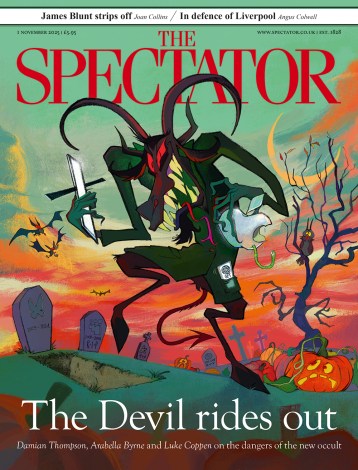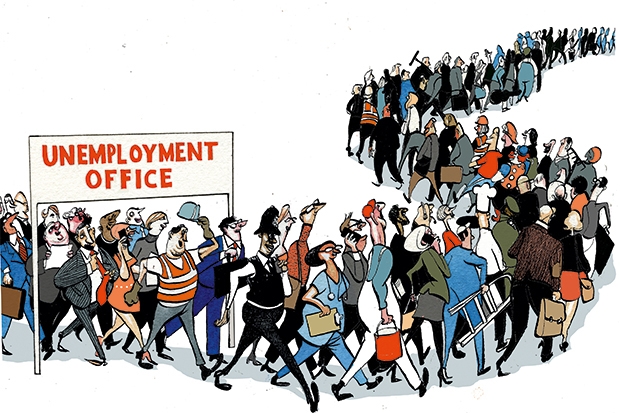‘Two million jobs have been created since 2010 — but there will not be a moment of rest until we have reached our goal,’ said David Cameron in a Telegraph article a fortnight before the election: ‘Two million more jobs; or full employment in Britain.’ It was a bold statement. Indeed you might think, given unemployment at 1.84 million in the winter quarter, that the target for new jobs was actually an error on the part of who-ever drafts the Prime Minister’s prose. Either way, it drew little attention amid the smoke of battle. But now the air has cleared it merits revisiting, because it connects all the key themes (except perhaps the Scottish one — so full of perils that, like the Scottish play, it is best not named) of the coming phase of national politics: aspiration, equality, spending cuts, immigration and EU membership.
What is full employment, and is it a feasible target? When George Osborne declared it to be so in April 2014, I called him ‘cheeky’ — even though his speech was followed by yet another sharp fall in jobless numbers. Full employment does not technically mean ‘everyone in work’; more like ‘everyone in full or part-time work who wants to be and is not resting between jobs’. Back in July 1955, it meant an unemployment rate of just 1 per cent, or 216,000 jobseekers.
In today’s more flexible labour market, it is reckoned to occur somewhere between 3 and 5 per cent unemployment (we’re currently at 5.6 per cent) and is easily confused with the ‘equilibrium jobless rate’ at which labour shortages begin to fuel inflationary wage claims. The Bank of England has put that at 5.1 per cent, which was the average unemployment rate from 2001 to 2007 — though economist Michael Saunders of Citi argues, ‘The labour market has changed so much over the past ten years that the equilibrium jobless rate may well be lower now than it was then.’
Enough theology — let’s assume the jobless rate goes on falling well below 5 per cent and into or beyond equilibrium territory. What are the implications? There were indeed two million jobs created since 2010 — and according to the Office for National Statistics, half of them were taken by immigrants. Suppose we really do create two million more. Even after netting off public sector job cuts to come with the next swing of Osborne’s axe, such a private-sector flourishing will boost total numbers in work to a peak high above the current record of 31 million: will that suck in immigrants at a similar rate to the past five years, and where will they live? Was Cameron’s gambit based on advice that the immigrants are coming anyway, so we’d better create jobs for them?
As for inflationary wage pressure in response to labour shortages, immigration is the obvious valve to keep it down. But rising wage rates are also a useful antidote to inequality — which remains a taint on Cameron and Osborne, or at least a taunt that makes them wince. Many Tory candidates told voters on the doorstep that they would be happy to see a significant rise in the statutory minimum wage. Wouldn’t it be better if the market pushed pay upwards anyway? Yes it would, so long as energy and import prices hold inflation down and — most importantly — productivity also improves. It has actually fallen by a fraction since 2007 (also ONS figures) and that in turn raises urgent issues to do with skills, technology and management.
Then again, a growing private-sector workforce means more taxpayers, and rising wage levels at the lower end of the scale mean less demand for in-work benefits — so full employment means that Osborne can balance his books quicker, with fewer painful welfare cuts. What can knock us off this beneficent trajectory? Events, dear boy, and Europe — whether by its own inevitable crisis, or one we manufacture all by ourselves.
My post-poll bender
As I slumped into an armchair on Sunday evening after what I can best describe as a three-day bender, a passage from Robert Burton’s The Anatomy of Melancholy, first published in 1621, swam to mind: ‘Now come tidings of weddings, maskings, mummeries, entertainments, jubilees, embassies, tilts and tournaments… now comical then tragical matters. Today we hear of new Lords and officers created, tomorrow of some great men deposed…’
The first reader who emails the name of the 1975 novel from which I borrowed that abbreviated quote will receive a signed copy of one of my books — but isn’t it exactly how public life arranges itself in Britain, the only nation on earth that sandwiches an epoch-making general election between the birth of a royal baby and a remembrance ceremony that stands sleepless political victors and vanquished shoulder to shoulder?
My own post-poll peregrination took me from a crawl of Mayfair’s oligarch bars (reader, I drank a ‘porn-star martini’ — Google the recipe — in a circle of hell called Novikov) to a wedding in the New Forest and reunions with friends old and young, north and south. Everywhere the mood was one of relief that the tiresome campaign was over, and the future unblighted by Milibandist dogma.
For the many twentysomethings I caught up with (though I can’t speak for the tall blonde ladies in Novikov, who would prosper under any regime but were too busy to talk to me), this week may be as tough as last for finding a graduate job, but in a broader sense there has never been a better moment to start a career or a business. For my own cohort turning 60, at least we shall live the first five years of our remaining span under a government that believes in enterprise as the path to national prosperity, and in the virtues of civil society. And we have choices: cash in the pension pot and go wild, devote ourselves to voluntary service, or go on working and earning for as long as we wish — because in a full-employment economy, our country needs us. Happy days, until the next crisis.

To find out more about the Spectator cruise, click here.







Comments